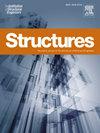Development of design formulas for predicting deflection in corrugated blast walls under explosion loads
IF 3.9
2区 工程技术
Q1 ENGINEERING, CIVIL
引用次数: 0
Abstract
A corrugated blast wall is a passive explosion protection system designed to safeguard people, structures, and surrounding areas from the cascading effects of explosion accidents. In designing these walls, maximum and/or permanent deflection is a crucial criterion for assessing blast resistance and ensuring structural integrity. Engineers typically use numerical methods, such as finite element analysis (FEA), or analytical methods, like single-degree-of-freedom (SDOF) analysis, to calculate deflections. However, these methods have certain limitations, including the need for specialized techniques, time consumption, and potential inaccuracies due to simplifications.
This study aims to develop design formulas that reduce the time required while enhancing accuracy in determining maximum and permanent deflections of corrugated blast walls under various explosion loads. The formulas were derived from 14,400 FEA cases, which assessed the blast wall’s capacity to withstand explosion loads across various design configurations, including height, thickness, and shape of the corrugated blast wall. Additionally, a Pressure-Impulse (PI) curve is plotted to illustrate the relationship between pressure and its duration during an explosion, aiding in the optimization of blast wall designs for maximum effectiveness in mitigating blast effects.
开发用于预测爆炸荷载下波纹防爆墙挠度的设计公式
波纹防爆墙是一种被动防爆系统,旨在保护人员、结构和周围区域免受爆炸事故的连带影响。在设计这些防爆墙时,最大和/或永久变形是评估抗爆性和确保结构完整性的关键标准。工程师通常使用有限元分析 (FEA) 等数值方法或单自由度 (SDOF) 分析等分析方法来计算挠度。然而,这些方法都有一定的局限性,包括需要专门的技术、耗费时间以及因简化而可能造成的误差。本研究旨在开发设计公式,以减少所需时间,同时提高确定波纹防爆墙在各种爆炸载荷下的最大和永久挠度的准确性。这些公式源自 14400 个有限元分析案例,这些案例评估了防爆墙在各种设计配置下承受爆炸载荷的能力,包括波纹防爆墙的高度、厚度和形状。此外,还绘制了压力-脉冲 (PI) 曲线,以说明爆炸期间压力与持续时间之间的关系,从而帮助优化防爆墙设计,最大限度地降低爆炸影响。
本文章由计算机程序翻译,如有差异,请以英文原文为准。
求助全文
约1分钟内获得全文
求助全文
来源期刊

Structures
Engineering-Architecture
CiteScore
5.70
自引率
17.10%
发文量
1187
期刊介绍:
Structures aims to publish internationally-leading research across the full breadth of structural engineering. Papers for Structures are particularly welcome in which high-quality research will benefit from wide readership of academics and practitioners such that not only high citation rates but also tangible industrial-related pathways to impact are achieved.
 求助内容:
求助内容: 应助结果提醒方式:
应助结果提醒方式:


